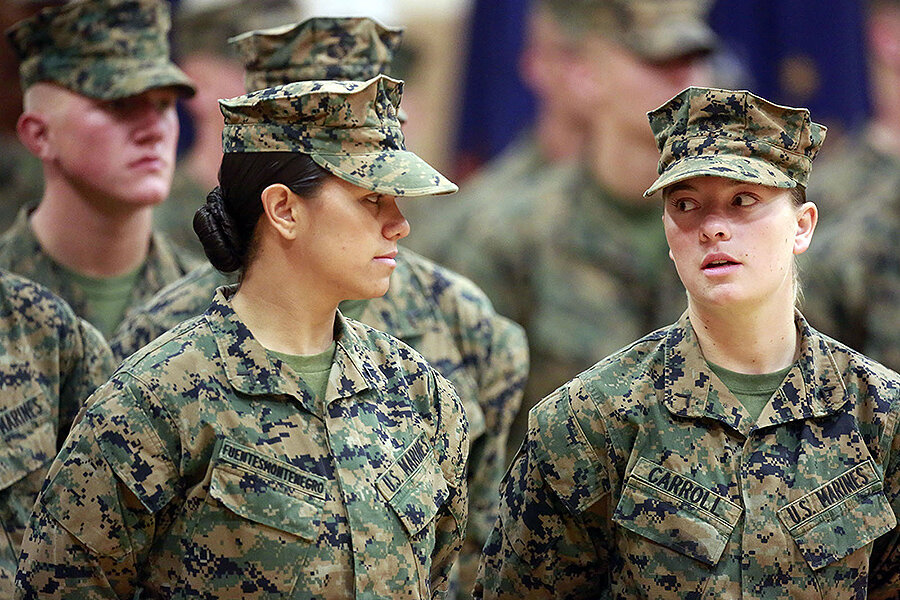All US military services must be open to women: Which branch will balk?
Loading...
"Diversity don't win wars," retired Col. Terry Stevens told the Air Force Times last March, protesting Secretary Deborah Lee James' calls to increase the number of women and minorities. "Warriors win wars."
On Thursday, however, US Defense Secretary Ash Carter ordered all branches of the military to open combat roles to women, the Associated Press reports, evidence of many military leaders' growing confidence that diversity does, in fact, win wars.
The decision is hardly a surprise, but the culmination of a years-long push in the armed forces to better integrate female service members in the name of not only fairness, but military strength.
"I'd be crazy" not to recruit from "half the American population," Secretary Carter told troops in Sicily this fall.
But that logic puts him in direct conflict with the Marines, who have forcefully argued that putting women in combat roles will undermine the hard-to-quantify character of the Few and the Proud, which some Corps leaders depict as a distinctly male brotherhood forged in difficult conditions.
An infantry unit "revels in the most crude and profane existence so that they may be more effective killers than their foe," retired Lieutenant General Gregory Newbold wrote for military news site War on the Rocks, pushing against full integration for women.
According to an anonymous defense official, Carter's plan calls for each branch to draft an inclusion strategy by January 1, and begin implementing them by April. Women will be eligible for elite programs like the Navy's SEALs.
Earlier this year, the Marine Corps was given an opportunity to make recommendations about including women in more combat roles, which led to a controversial Corps study released in September. Based on experiments with 200 male and 75 female volunteers put in combat training, the Marines concluded that coed units would be less effective than all-male ones because of women's lower average strength, among other reasons.
Critics said that women's lower performance was due to separate training and standards for men and women, and point to situations where trainers and colonels simply told women they needed to meet the same criteria as men. After proper training, they did. However, a common assumption from anti-inclusion voices is that de facto "quotas" for women will lower the military's standards.
The Marines stand as the last branch to resist putting women in combat. In 1994, when the Pentagon ended policies keeping women away from the front lines, some branches began by opening combat-supply jobs to women – and in today's wars, they say, non-infantry roles are often just as dangerous. "They’re fighting and they’re dying together, and the time has come for our policies to recognize that reality," then-Defense Secretary Leon Panetta said before lifting the Pentagon's rules against women in close-combat positions.
Today, at least 16 countries allow women in combat roles, from Canada to Australia.
But the Marines have held off, although a memo obtained exclusively by The Christian Science Monitor in September shows that the Corps has discussed how better screening and supportive leadership could ease a transition to coed combat.
"What we’ve seen play out over the years is that the Marines are behind the power curve, and the Army is out in front," former Corps trainer Greg Jacob told the Monitor in September.
But some Marine leaders say their own legendary strength will be lost if women fight alongside men, and their arguments focus on culture, psychology, and a "band of brothers" ideal as much as physical prowess.
According to Lieutenant General Gregory Newbold's anti-inclusion piece,
In this direct ground combat environment, you do not fight for an ideal, a just cause, America, or Mom and apple pie. You endure the inhumanity and sacrifices of direct ground combat because, "Greater love hath no man than this, that a man lay down his life for his friends."
But Newbold maintains that sexual desire and jealousy could "degrade the nearly spiritual glue that enables the infantry to achieve the illogical and endure the unendurable."
"If I’m wrong, the cost may be denied opportunity to strong and impressive young women. If you’re wrong, our national security is shaken and there is a butcher’s bill to pay. Make your choice," he warned.
But inclusion advocates, like Air Force Secretary Deborah Lee James and Navy Secretary Ray Mabus, say that misses the point: women make the forces stronger. For instance, female soldiers can more easily interact with women in cultures with conservative gender divides, such as Iraq and Afghanistan.
More than 200,000 women are in the US armed forces today, including over 9,000 in deployment, and compose nearly a third of the forces' enlisted medical and administrative staff.
Rather than wait for all military personnel to get on board with women in combat, some leaders say the US should include them first, then stand back and watch acceptance grow. Men who have worked with women before tend to be less concerned about inclusion, according to Pentagon studies, and some of the strongest resistance comes from retired staff.








